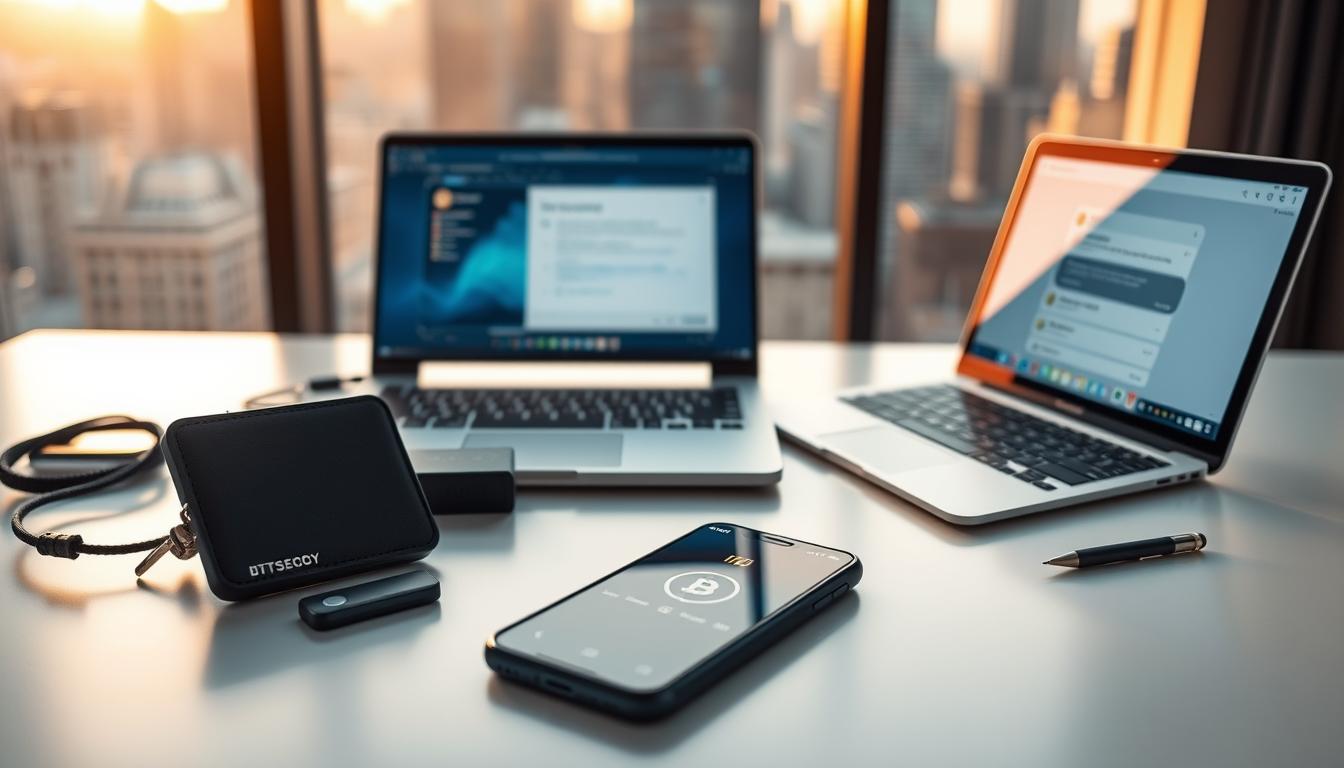Now Reading: Mastering Blockchain Development: A Comprehensive Guide
- 01
Mastering Blockchain Development: A Comprehensive Guide
Mastering Blockchain Development: A Comprehensive Guide
Blockchain technology has changed how we view data security, transparency, and decentralized networks. It’s the core of cryptocurrencies like Bitcoin. Blockchain development is now a top skill in tech.
This guide is here to help you understand blockchain technology and advanced development. It’s for both newbies and seasoned developers. It gives you the tools to excel.

This guide will teach you how to set up development environments. You’ll learn to build decentralized applications. It’s all you need to become a pro in blockchain development.
Key Takeaways
- Understanding the basics of blockchain technology
- Setting up a development environment for blockchain projects
- Choosing the right blockchain platforms for your needs
- Building decentralized applications (dApps)
- Advanced techniques in blockchain development
Understanding Blockchain Technology Fundamentals
To understand blockchain, you need to know its basics. It’s not just a trend; it’s a new way to record data. This method is secure and open to all.
What is Blockchain Technology?
Blockchain is a system that keeps records on many computers. It makes sure the data is safe and clear. This system creates a permanent record that many computers keep, not just one.
Key Components of a Blockchain
A blockchain has important parts that make it work well.
Blocks and Transactions
A block holds transactions that are checked and added to the blockchain. These transactions are about data or asset exchanges between people.
Cryptographic Hash Functions
Cryptographic hash functions are key to keeping the blockchain safe. They make a unique digital mark for each block. This makes it easy to spot if someone tries to change the data.
Consensus Mechanisms Explained
Consensus mechanisms are vital in blockchain. They help the network agree on the blockchain’s state. Each mechanism has its own benefits and drawbacks.
Proof of Work vs. Proof of Stake
Proof of Work (PoW) and Proof of Stake (PoS) are well-known. PoW needs miners to solve hard puzzles. PoS asks validators to use their own cryptocurrency to help validate.
Other Consensus Algorithms
There are more consensus algorithms like Delegated Proof of Stake (DPoS) and Byzantine Fault Tolerance (BFT). Each has its own strengths and uses.
The Evolution of Blockchain Development
Blockchain development has grown a lot since Bitcoin started it all. It has evolved significantly over time. Now, it’s a strong system that supports many different uses.
From Bitcoin to Modern Blockchain Platforms
Bitcoin was the first to show us a decentralized ledger. But today’s blockchain platforms have expanded on this concept. They offer better scalability, security, and features. Ethereum, Hyperledger Fabric, and Binance Smart Chain are key players in this field.
Key Milestones in Blockchain Development
There have been a few big steps in blockchain’s growth. Two major ones are the Smart Contract Revolution and Enterprise Blockchain Adoption.
Smart Contract Revolution
Smart contracts, especially with Ethereum, changed the game. They let us build decentralized apps (DApps) and DeFi protocols. This made blockchain more than just for transactions.
Enterprise Blockchain Adoption
As blockchain got better, companies started using it. They used it for things like managing supply chains and checking identities. This led to the creation of blockchain platforms and solutions for businesses.
Blockchain’s growth shows its huge potential. As it keeps getting better, we’ll see even more cool uses and wider use across different fields.
Setting Up Your Blockchain Development Environment
Setting up your blockchain development environment is key to starting your projects. A good setup lets developers build, test, and deploy apps smoothly.
Essential Tools and Software
You’ll need the right tools and software to begin. This includes code editors and IDEs for a great coding experience. Visual Studio Code and IntelliJ IDEA are top choices, with lots of plugins for blockchain.
Code Editors and IDEs
For example, Visual Studio Code has many blockchain development extensions. These include tools for Solidity, used in Ethereum smart contracts. IntelliJ IDEA also has plugins to improve your development.
Blockchain Development Kits
A Blockchain Development Kit is also crucial. It includes libraries, APIs, and tools to make development easier. The Tatum Blockchain Development Environment is a great example, offering everything you need to build blockchain apps.
Development Frameworks Overview
Development frameworks are vital for faster development. They offer pre-built functions and structures to save time. Truffle and Web3.js are top choices for blockchain development, making it easier to work with blockchain networks.
Local Blockchain Setup for Testing
Setting up a local blockchain environment is essential for testing. Tools like Ganache for Ethereum and Docker Containers for various networks let developers test in a controlled space.
Setting Up Ganache for Ethereum
Ganache gives you a personal Ethereum blockchain for deploying contracts and testing apps. It’s perfect for Ethereum developers, allowing quick testing without a public testnet.
Docker Containers for Blockchain Networks

Docker Containers make it easy to manage blockchain networks locally. They let you switch between different setups and versions, making development more flexible.
Choosing the Right Blockchain Platform
Blockchain technology is growing fast. It’s key to know the good and bad of different platforms. The right platform can make or break a blockchain app.
Ethereum Development Ecosystem
Ethereum is a top choice for many. It has a strong ecosystem and lots of users. Its Ethereum Virtual Machine (EVM) lets developers make smart contracts and DApps.
EVM Compatibility
The EVM is vital for Ethereum. It makes sure smart contracts work well on the network. This means apps can run smoothly on different platforms.
Ethereum Development Tools
Ethereum has many tools for developers. Truffle Suite and Web3.js help make, test, and deploy smart contracts and DApps.
Hyperledger Fabric for Enterprise Solutions
Hyperledger Fabric is for big businesses. It’s a permissioned blockchain. Companies can make their own blockchain networks with it.
Binance Smart Chain Development
Binance Smart Chain (BSC) is popular for its EVM compatibility and low fees. It’s a good choice for DApp developers.
Solana, Polkadot, and Other Emerging Platforms
Solana and Polkadot are new and exciting. Solana is fast, and Polkadot connects different blockchains.
Choosing a platform is all about scalability, security, and support. Knowing each platform’s strengths helps developers pick the best for their projects.
Programming Languages for Blockchain Development
Programming languages are key in blockchain development. They help make smart contracts and apps. The choice of language depends on the blockchain platform.
Solidity for Ethereum-based Development
Solidity is the main language for Ethereum smart contracts. It’s like JavaScript, making it easy for web developers to use.
Solidity Syntax Basics
Solidity uses contract-oriented programming. This means contracts have state variables and functions. Knowing Solidity basics is vital for making secure smart contracts.
Solidity Development Environment
To start with Solidity, you need tools like Truffle Suite and Remix IDE. Truffle helps with smart contract deployment and testing. Remix is a web-based IDE for writing and debugging Solidity contracts.
Rust for Substrate and Solana
Rust is becoming popular for Substrate and Solana. It’s known for safety and performance, making it great for fast blockchain apps.
JavaScript and Python in Blockchain Development
JavaScript and Python are used for blockchain frontend apps. JavaScript works with Web3.js for Ethereum, while Python uses Web3.py for similar tasks.
These languages let developers make many blockchain apps. From simple scripts to complex decentralized apps.
Smart Contract Development Fundamentals
Smart contracts are self-executing contracts with code that outlines the agreement. They change how we view contract execution and enforcement. For blockchain developers, knowing how to develop smart contracts is key.
Writing Your First Smart Contract
Creating a smart contract starts with picking a programming language. For Ethereum projects, Solidity is the top choice. Let’s explore the basic structure of a smart contract.
Contract Structure and Syntax
A smart contract starts with its version declaration and library imports. It’s structured like object-oriented programming languages. This makes it easy for developers who know Java or C++.
For instance, a simple Solidity contract might look like this:
pragma solidity ^0.8.0;
contract SimpleContract {
uint public count;
constructor() {
count = 0;
}
function increment() public {
count++;
}
}
State Variables and Functions
State variables store data on the blockchain. Functions interact with or change this data. In our example, count is a state variable, and increment() changes it.
Smart Contract Design Patterns
Following design patterns is key for strong and easy-to-maintain smart contracts. Patterns include access modifiers and emergency stop mechanisms. These help handle unexpected situations.
Testing Smart Contracts
Testing is vital to ensure smart contracts work as expected and are secure. Tools like Truffle and Hardhat help write and run tests.
Unit Testing with Truffle and Hardhat
Truffle and Hardhat support unit testing for smart contracts. These tests are in JavaScript. They let developers test various scenarios and edge cases.
Security Testing Approaches
Security testing is crucial to find vulnerabilities. Techniques include static analysis, fuzz testing, and formal verification. These methods ensure smart contracts are correct and secure.
Building Decentralized Applications (DApps)
DApps are changing how we use blockchain technology. They offer a secure and transparent way to build applications. This makes them more robust and easier to use.
DApp Architecture and Components
DApp architecture is unique because it’s decentralized. A typical DApp has two main parts: the frontend and the backend.
Backend vs. Frontend in DApps
The backend of a DApp runs on blockchain technology. It uses smart contracts for data and logic. The frontend, on the other hand, is what users see. It’s built with web technologies like JavaScript and HTML.
Data Flow in Decentralized Applications
Data flow in DApps connects the user interface, smart contracts, and blockchain networks. It’s key for making DApps efficient and user-friendly. Efficient data flow makes apps responsive and scalable.
Frontend Development for DApps
Frontend development for DApps creates interfaces that work with blockchain networks. Developers use Web3.js and Ethers.js to make this happen.
Connecting to Web3 Infrastructure
To link a DApp to Web3 infrastructure, developers integrate libraries for blockchain interaction.
Web3.js and Ethers.js Libraries
Web3.js helps interact with the Ethereum blockchain with ease. Ethers.js offers a robust interface for Ethereum interactions.
Wallet Integration Techniques
Wallet integration is key for DApps. It lets users securely interact with the blockchain. Techniques include using wallet providers like MetaMask for smooth transactions and smart contract interactions.
Understanding DApp architecture and using the right tools helps developers create strong DApps. As the field grows, keeping up with trends and best practices is crucial for success.
Blockchain Development Best Practices
To succeed in blockchain development, following best practices is key. It requires technical skills, knowledge of the blockchain world, and sticking to professional standards.
Code Optimization and Gas Efficiency
Optimizing code for gas efficiency is crucial. It affects transaction costs and performance. Developers should:
- Reduce unnecessary computations
- Choose gas-efficient data structures
- Optimize smart contract functions
Documentation Standards
Keeping high documentation standards is vital for blockchain projects. It means:
- Writing clear and concise code comments
- Documenting smart contracts and DApps thoroughly
- Keeping documentation up to date
Version Control for Blockchain Projects
Effective version control is key for managing blockchain project changes. It involves:
Git Workflows for Smart Contracts
Using Git workflows for smart contract development boosts collaboration and version management.
Managing Dependencies
Managing dependencies well is essential for a secure and stable blockchain project.
- Keep dependencies up to date
- Watch for vulnerabilities
By following these blockchain development best practices, developers can make sure their projects are efficient, secure, and well-kept.
Security Considerations in Blockchain Development
Keeping blockchain apps safe is key to avoiding financial losses and keeping users’ trust. As the blockchain world grows, so does the need to tackle security risks.
Common Vulnerabilities and Attack Vectors
Blockchain faces threats like reentrancy attacks and integer overflow/underflow. Reentrancy attacks happen when an attacker keeps taking money from a contract by re-entering it before the first call is done.
Reentrancy Attacks
To stop reentrancy attacks, developers use the Checks-Effects-Interactions pattern. This makes sure state changes happen before talking to other contracts.
Integer Overflow and Underflow
Integer overflow and underflow occur when numbers go beyond what an integer can hold. This can cause problems. Using libraries like OpenZeppelin’s SafeMath helps fix these issues.
Security Auditing Tools and Techniques
Regular security checks are vital to find vulnerabilities. Tools like Mythril and Oyente help check smart contracts for security risks.
Implementing Secure Design Patterns
Secure design patterns, like access control mechanisms and emergency stop patterns, are key to better blockchain security.
Access Control Mechanisms
Good access control makes sure only the right people can do sensitive things. This is done with role-based access control.
Emergency Stop Patterns
An emergency stop or circuit breaker pattern lets developers stop a contract if needed. This stops more damage.

By knowing common threats and using secure design patterns, developers can make their blockchain apps much safer.
Testing and Deploying Blockchain Applications
Testing is key in making blockchain apps work well. It’s about making sure they are reliable, secure, and successful.
Testing Strategies for Blockchain Code
Good testing strategies are vital for finding and fixing bugs in blockchain code. They use automated testing frameworks and simulation/stress testing to test different scenarios.
Automated Testing Frameworks
Automated testing tools are essential for keeping blockchain apps in check. Tools like Truffle and OpenZeppelin help developers test their smart contracts. This ensures the code works right under various conditions.
Simulation and Stress Testing
Simulation and stress testing are important for seeing how apps perform under heavy use or extreme conditions. They help find potential problems and make sure apps can handle lots of activity.
Mainnet vs. Testnet Deployment
Choosing between mainnet and testnet is a big decision for deploying blockchain apps. Mainnet is where the app goes live on the real blockchain. Testnet is for testing on a fake network, without risking real assets.
Continuous Integration for Blockchain Projects
Continuous Integration (CI) means regularly updating code and running tests. It’s vital for blockchain projects to catch problems early and keep the app stable and secure.
By using these strategies, developers can make sure their blockchain apps are strong, dependable, and ready for the real world.
Real-world Blockchain Development Use Cases
Blockchain is versatile and changing many sectors, from finance to healthcare. It’s known for its secure, transparent, and efficient solutions. This makes it a favorite in many industries.
Financial Services Applications
Blockchain has changed finance, offering new ways to handle money.
DeFi Protocol Development
Decentralized Finance (DeFi) is a big deal now. It lets people lend, borrow, and trade without banks. DeFi platforms like Uniswap and Compound show blockchain’s power in finance.
Tokenization Platforms
Tokenization turns assets into digital tokens on blockchain. It’s a new way to invest and manage assets. This makes assets more liquid and allows for partial ownership.
Supply Chain Solutions
Blockchain makes supply chains more transparent and efficient. It helps track products from start to finish. This cuts down on counterfeits and improves inventory control.
- Enhanced tracking and tracing capabilities
- Improved supply chain visibility
- Reduced counterfeiting through immutable records
Healthcare and Identity Management
In healthcare, blockchain is used for secure medical records and identity checks. It gives patients control over their health data. This boosts privacy and security.
Blockchain is changing many industries. As it grows, we’ll see even more new uses.
Overcoming Challenges in Blockchain Development
The future of blockchain depends on solving big challenges like scalability and interoperability. As blockchain grows, tackling these issues is key for its global use and success.
Scalability Solutions
Scalability is a big hurdle in blockchain development. To tackle it, developers are looking at different ways to solve the problem.
Sharding Techniques
Sharding breaks the blockchain into smaller parts called shards. This makes it possible to handle more transactions at once, boosting scalability.
Optimistic Rollups
Optimistic Rollups help by moving some transactions off the main chain. This reduces the network’s load and speeds up processing.
Interoperability Between Blockchains
Interoperability between blockchains is vital for a unified ecosystem. It lets different blockchain platforms work together smoothly, making blockchain technology more useful and functional.
- Enables cross-chain transactions
- Facilitates data sharing between blockchains
- Promotes a more interconnected blockchain ecosystem
Regulatory Compliance Considerations
Blockchain development must also deal with regulatory compliance. It’s important to make sure blockchain apps follow the law to gain acceptance and success.

Advanced Blockchain Development Techniques
Blockchain tech is growing fast, and developers are using new ways to make it better. They focus on making it faster, more connected, and useful. These advanced methods are key for the next big things in blockchain.
Layer2 Solutions and State Channels
Layer2 solutions and state channels help make blockchain faster and cheaper. They move transactions off the main chain, reducing traffic and costs. Layer2 solutions like Optimistic Rollups and zk-Rollups are making transactions quicker and cheaper.
Cross-chain Development
Cross-chain development lets different blockchains talk and work together. This is important for a more connected and useful blockchain world. Cross-chain bridges help move assets and data between chains, opening up new possibilities for apps.
Oracle Integration for External Data
Oracles are a safe way to add outside data to blockchain apps. This is key for smart contracts that need real-world info to work. Chainlink is a top oracle service that gives reliable data feeds.
Using Chainlink in apps means adding its oracle nodes for real-time data. This makes smart contracts more reliable and useful.
Building Custom Oracles
For special needs, developers might create their own oracles. This means making a custom solution that safely and accurately gives the needed data to apps.
Navigating Your Blockchain Development Journey
Starting your blockchain development journey means understanding blockchain technology well. This guide has covered everything from the basics to advanced techniques. It aims to give developers the skills they need.
Blockchain tech is always changing. It’s important to keep up with new trends and best practices. Developers can learn more by looking at real-world uses, like in finance and supply chains. They can also dive into topics like layer2 solutions and cross-chain development.
This guide is like a roadmap for blockchain development. By learning the skills here, developers can make new blockchain apps. This helps grow and use blockchain technology more.
Learning and exploring are key to doing well in this field. As blockchain grows, developers must keep learning and improving. This helps them stay at the forefront of blockchain.
FAQ
What is the first step in getting started with blockchain development?
First, learn about blockchain basics. This includes its main parts and how it agrees on data. Also, set up a development space with the right tools and software.
How do I choose the right blockchain platform for my project?
Pick a platform based on your project’s needs. Look at the type of app, how scalable it needs to be, and the development community. Popular choices are Ethereum, Hyperledger Fabric, and Binance Smart Chain.
What programming languages are used in blockchain development?
Main languages are Solidity for Ethereum, Rust for Substrate and Solana, and JavaScript and Python for many apps. The choice often matches the platform.
How do I ensure the security of my blockchain application?
To keep it secure, know common threats and use auditing tools. Implement secure patterns, like access controls and emergency stops.
What are some best practices for blockchain development?
Optimize code for gas, keep good documentation, and use version control. Git workflows and managing dependencies are key.
How do I test and deploy my blockchain application?
Test with automated tools, simulations, and stress tests. Deploy on mainnet or testnet. Continuous integration ensures reliability.
What are some real-world applications of blockchain technology?
It’s used in finance (DeFi, tokenization), supply chain, healthcare (identity), and more. Knowing these areas helps find project ideas.
How can I overcome scalability challenges in blockchain development?
Use sharding, optimistic rollups, and Layer2 solutions. Learning these can make your apps more scalable.
What is the role of oracles in blockchain development?
Oracles bring external data to apps, enabling real-world interaction. Chainlink is a top oracle solution. Knowing how to use oracles is key for some projects.
How do I stay updated with the latest developments in blockchain technology?
Keep learning, follow industry news, and join blockchain communities. Understanding tech evolution and trends is vital for success.















